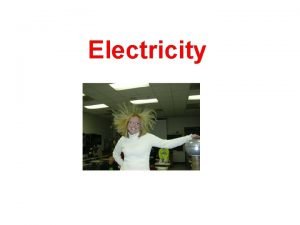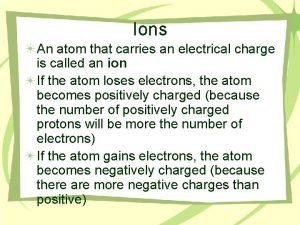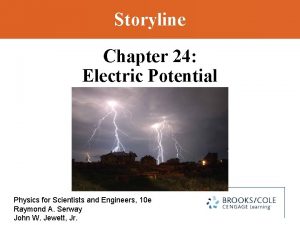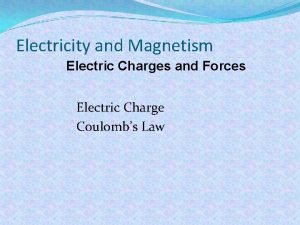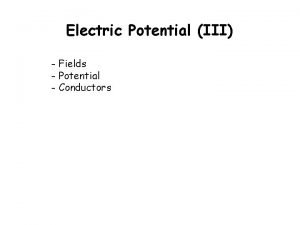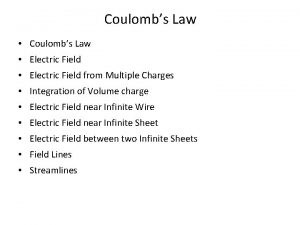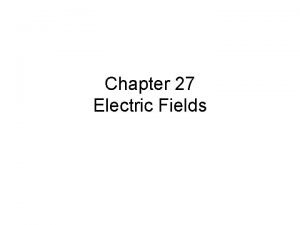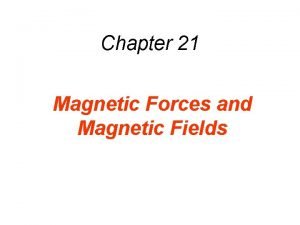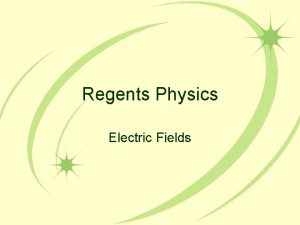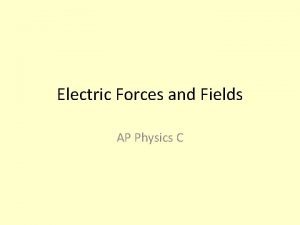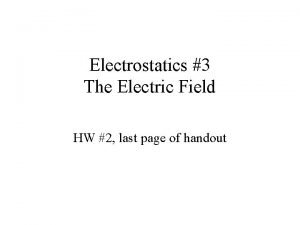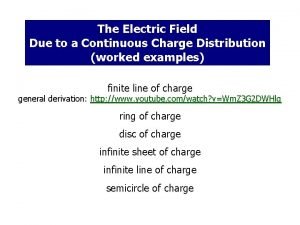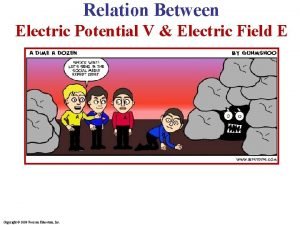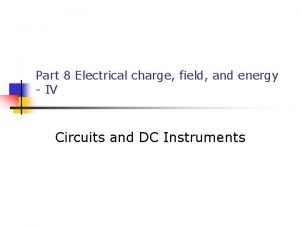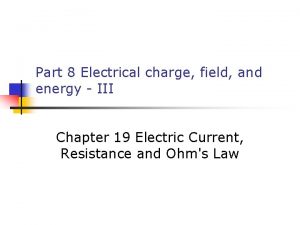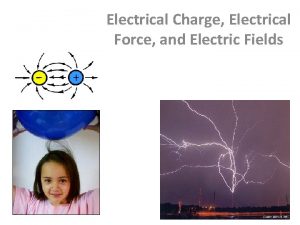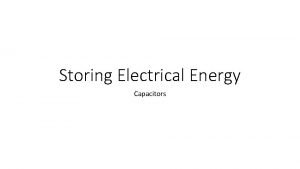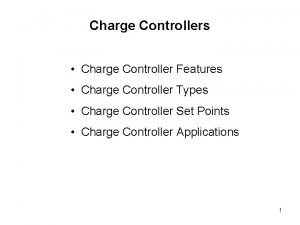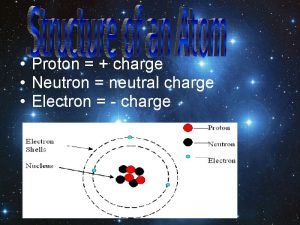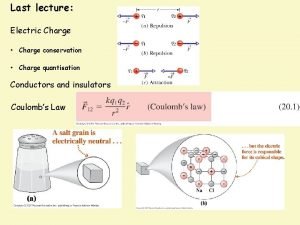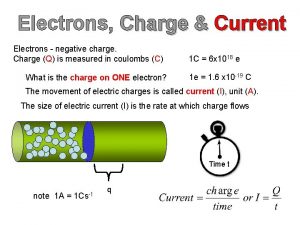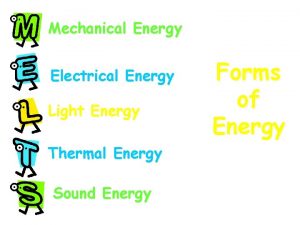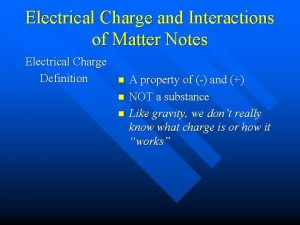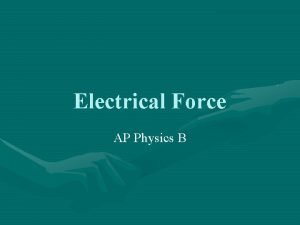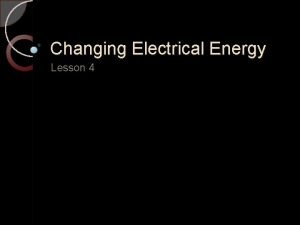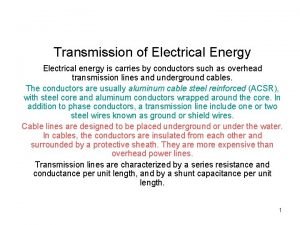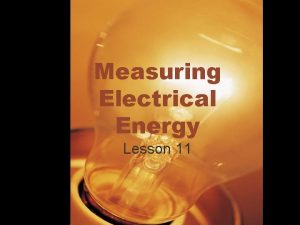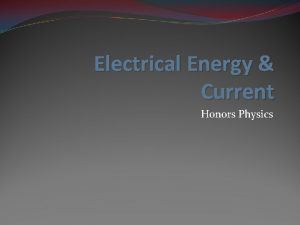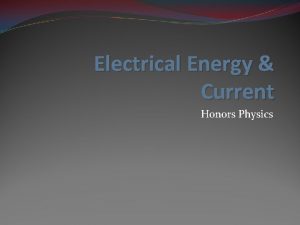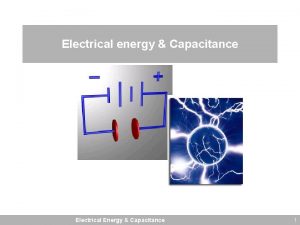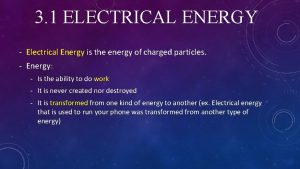Part 8 Electrical charge field and energy II




































- Slides: 36

Part 8 Electrical charge, field, and energy - II Chapter 18 Electric potential and Electric Energy

Electric Potential Energy n n n The electrostatic force is a conservative force It is possible to define an electrical potential energy function with this force Work done by a conservative force is equal to the negative of the change in potential energy

Work and Potential Energy n n There is a uniform field between the two plates As the charge moves from A to B, work is done on it W = Fd=q Ex (xf – xi) ΔPE = - W = - q Ex (xf – xi) n this equation only for a uniform field

Potential Difference n The potential difference between points A and B is defined as the change in the potential energy (final value minus initial value) of a charge q moved from A to B divided by the size of the charge n n ΔV = VB – VA = ΔPE / q ΔPE = q ΔV

Potential Difference, cont. n n Both electric potential energy and potential difference are scalar quantities Units of potential difference n n V = J/C Uniform electric field n DV = VB – VA= -Ex Dx n n About units: N/C = V/m Potential difference but not the absolute value of the electric potential

Energy and Charge Movements n n A positive charge gains electrical potential energy when it is moved in a direction opposite the electric field If a charge is released in the electric field, it experiences a force and accelerates, gaining kinetic energy n n As it gains kinetic energy, it loses an equal amount of electrical potential energy A negative charge loses electrical potential energy when it moves in the direction opposite the electric field

Summary of Positive Charge Movements and Energy n When a positive charge is placed in an electric field n n It moves in the direction of the field It moves from a point of higher potential to a point of lower potential Its electrical potential energy decreases Its kinetic energy increases

Electric Potential of a Point Charge n n n The point of zero electric potential is taken to be at an infinite distance from the charge The potential created by a point charge q at any distance r from the charge is A potential exists at some point in space whether or not there is a test charge at that point

Electric Field and Electric Potential Depend on Distance n n The electric field is proportional to 1/r 2 The electric potential is proportional to 1/r

Electric Potential of Multiple Point Charges n n Superposition principle applies The total electric potential at some point P due to several point charges is the algebraic sum of the electric potentials due to the individual charges n The algebraic sum is used because potentials are scalar quantities

Electrical Potential Energy of Two Charges n n n V 1 is the electric potential due to q 1 at some point P The work required to bring q 2 from infinity to P without acceleration is q 2 V 1 This work is equal to the potential energy of the two particle system

Problem Solving with Electric Potential (Point Charges) n Draw a diagram of all charges n n n Note the point of interest Calculate the distance from each charge to the point of interest Use the basic equation V = keq/r n n Include the sign The potential is positive if the charge is positive and negative if the charge is negative

Problem Solving with Electric Potential, cont n Use the superposition principle when you have multiple charges n n Take the algebraic sum Remember that potential is a scalar quantity n So no components to worry about

Potentials and Charged Conductors n n n Since W = -q(VB – VA), no work is required to move a charge between two points that are at the same electric potential n W = 0 when VA = VB All points on the surface of a charged conductor in electrostatic equilibrium are at the same potential Therefore, the electric potential is a constant everywhere on the surface of a charged conductor in equilibrium

The Electron Volt n The electron volt (e. V) is defined as the energy that an electron gains when accelerated through a potential difference of 1 V n n Electrons in normal atoms have energies of 10’s of e. V Excited electrons have energies of 1000’s of e. V High energy gamma rays have energies of millions of e. V 1 e. V = 1. 6 x 10 -19 J

Equipotential Surfaces n An equipotential surface is a surface on which all points are at the same potential n n No work is required to move a charge at a constant speed on an equipotential surface The electric field at every point on an equipotential surface is perpendicular to the surface

Equipotentials and Electric Fields Lines – Positive Charge n n The equipotentials for a point charge are a family of spheres centered on the point charge The field lines are perpendicular to the electric potential at all points Further readings.

Equipotentials and Electric Fields Lines – Dipole n n n Equipotential lines are shown in blue Electric field lines are shown in red The field lines are perpendicular to the equipotential lines at all points Further readings.

Capacitance n n A capacitor is a device used in a variety of electric circuits The capacitance, C, of a capacitor is defined as the ratio of the magnitude of the charge on either conductor (plate) to the magnitude of the potential difference between the conductors (plates)

Capacitance, cont n n Units: Farad (F) n n 1 F=1 C/V A Farad is very large n Often will see µF or p. F

Parallel-Plate Capacitor n n The capacitance of a device depends on the geometric arrangement of the conductors For a parallel-plate capacitor whose plates are separated by air: 0=8. 85*10 -12 F/m, permittivity of free space

Parallel-Plate Capacitor, Example n n n The plates carry equal and opposite charges When connected to the battery, charge is pulled off one plate and transferred to the other plate The transfer stops when DVcap = DVbattery

Electric Field in a Parallel. Plate Capacitor n The electric field between the plates is n n n uniform Near the center Nonuniform near the edges For large caoacitor: the field may be taken as constant throughout the region between the plates

Applications of Capacitors – Camera Flash n The flash attachment on a camera uses a capacitor n n n A battery is used to charge the capacitor The energy stored in the capacitor is released when the button is pushed to take a picture The charge is delivered very quickly, illuminating the subject when more light is needed

Capacitors in Circuits n n A circuit is a collection of objects usually containing a source of electrical energy (such as a battery) connected to elements that convert electrical energy to other forms A circuit diagram can be used to show the path of the real circuit

Capacitors in Parallel n The total charge is equal to the sum of the charges on the capacitors n n Qtotal = Q 1 + Q 2 The potential difference across the capacitors is the same n And each is equal to the voltage of the battery

More About Capacitors in Parallel n The capacitors can be replaced with one capacitor with a capacitance of Ceq n The equivalent capacitor must have exactly the same external effect on the circuit as the original capacitors

Capacitors in Series n n n When a battery is connected to the circuit, electrons are transferred from the left plate of C 1 to the right plate of C 2 through the battery As this negative charge accumulates on the right plate of C 2, an equivalent amount of negative charge is removed from the left plate of C 2, leaving it with an excess positive charge All of the right plates gain charges of –Q and all the left plates have charges of +Q

More About Capacitors in Series n n An equivalent capacitor can be found that performs the same function as the series combination The potential differences add up to the battery voltage

Capacitors in Series, cont n n The equivalent capacitance of a series combination is always less than any individual capacitor in the combination

Problem-Solving Strategy n n Be careful with the choice of units Combine capacitors following the formulas n When two or more unequal capacitors are connected in series, they carry the same charge, but the potential differences across them are not the same n The capacitances add as reciprocals and the equivalent capacitance is always less than the smallest individual capacitor

Problem-Solving Strategy, cont n Combining capacitors n When two or more capacitors are connected in parallel, the potential differences across them are the same n n The charge on each capacitor is proportional to its capacitance The capacitors add directly to give the equivalent capacitance

Problem-Solving Strategy, final n Repeat the process until there is only one single equivalent capacitor n A complicated circuit can often be reduced to one equivalent capacitor n n n Replace capacitors in series or parallel with their equivalent Redraw the circuit and continue To find the charge on, or the potential difference across, one of the capacitors, start with your final equivalent capacitor and work back through the circuit reductions

Problem-Solving Strategy, Equation Summary n Use the following equations when working through the circuit diagrams: n n n Capacitance equation: C = Q / DV Capacitors in parallel: Ceq = C 1 + C 2 + … Capacitors in parallel all have the same voltage differences as does the equivalent capacitance Capacitors in series: 1/Ceq = 1/C 1 + 1/C 2 + … Capacitors in series all have the same charge, Q, as does their equivalent capacitance

Energy Stored in a Capacitor n n Energy stored = ½ Q ΔV From the definition of capacitance, this can be rewritten in different forms

Home Work n n n Problem 18. 14 at page 474 Problem 18. 31 at page 474 Problem 18. 70 at page 476
 Energy equation
Energy equation How to convert mechanical energy to electrical energy
How to convert mechanical energy to electrical energy Strong electric current
Strong electric current Difference between charge and electric charge
Difference between charge and electric charge Electrons flowing
Electrons flowing Chapter 21 electric charge and electric field
Chapter 21 electric charge and electric field Chapter 21 electric charge and electric field
Chapter 21 electric charge and electric field Coulombs constant units
Coulombs constant units Chapter 21 electric charge and electric field
Chapter 21 electric charge and electric field Electrical charge
Electrical charge An atom that carries a charge is called
An atom that carries a charge is called Energy energy transfer and general energy analysis
Energy energy transfer and general energy analysis Energy energy transfer and general energy analysis
Energy energy transfer and general energy analysis Electric field and magnetic field difference
Electric field and magnetic field difference Electric field and magnetic field difference
Electric field and magnetic field difference Data types and field properties
Data types and field properties Field dependent definition
Field dependent definition Difference between electric field and magnetic field
Difference between electric field and magnetic field Electric field of a finite line charge
Electric field of a finite line charge Force of magnetic field
Force of magnetic field Does magnetic field exerts force on a static charge
Does magnetic field exerts force on a static charge Coulomb to volt
Coulomb to volt Electric force equation
Electric force equation Electric field of a finite line charge
Electric field of a finite line charge Electric field for infinite line charge
Electric field for infinite line charge Electric field vector formula
Electric field vector formula Does magnetic field exerts force on a static charge
Does magnetic field exerts force on a static charge Properties of coulomb's law
Properties of coulomb's law Electric field lines about a point charge extend
Electric field lines about a point charge extend Electric field of line charge
Electric field of line charge Force on charge in electric field
Force on charge in electric field Electric field due to a continuous charge distribution
Electric field due to a continuous charge distribution Pros and cons of electrical energy
Pros and cons of electrical energy Individual differences in second language learning
Individual differences in second language learning Field dependent vs field independent
Field dependent vs field independent Waveguide cutoff frequency
Waveguide cutoff frequency The relation between electric field e and potential v is
The relation between electric field e and potential v is


